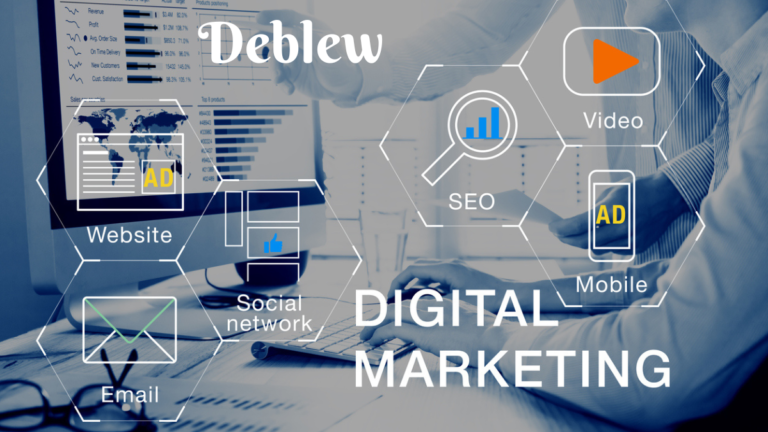Business Strategy and Management of Digital Marketing
The success of any business is dependent upon a well-planned and executed strategy. Digital marketing has become an essential part of this equation, giving organizations the ability to reach their target audiences on various digital platforms.
However, effective business strategies must be developed to successfully manage digital marketing campaigns. This article will explore best practices for developing and managing a successful digital marketing strategy that maximizes campaign performance and return on investment (ROI).
Strategy: Whose definition?
Strategic planning, decision-making, mission statements, and goal setting are all terms that have been associated with the strategy for decades. But what does “strategy” mean to each individual or organization? With so many different interpretations of the concept, it can be difficult to achieve a unified understanding of what “strategy” is.
The term ‘strategy’ has been defined differently by various authors, academics and business professionals over the years. While some view it as a set of ideas and techniques used to get an edge on competitors, others define it as a plan outlining how resources should be deployed to further organizational goals.
Prospectors
Prospector strategy has become an invaluable tool for businesses looking to increase their customer base and boost profits. This strategy focuses on finding large groups of potential customers that could benefit from a business’s services or products.
By taking the time to identify, reach out to, and engage with these target audiences, businesses can greatly expand their reach and create more opportunities for success.
The Prospectors Strategy involves three main steps:
- Research,
- Outreach,
- and Engagement.
First, businesses must do thorough market research into what types of people are likely to be interested in their offerings and which channels they should target to reach them effectively.
Second, businesses must craft personalised messages that will appeal to their prospects’ interests so they are encouraged to respond positively.
Analysers
Analysers Strategy is a concept that puts the power of data analysis in the hands of business owners and managers. By leveraging existing technology and resources, companies can use Analysers Strategy to gain more insight into their operations, customers, competitors, and industry trends.
The Analysers Strategy involves using analytical tools such as data mining, machine learning algorithms, natural language processing (NLP), and artificial intelligence (AI) to uncover key insights from big data.
This strategy helps organizations make informed decisions based on reliable information. For instance, they can use analytics to better understand customer behaviour or identify potential growth opportunities.
Additionally, by studying competitor strategies and industry trends through analytics-driven insights, businesses can stay ahead of the pack in their respective markets.
Low-Cost Defenders
The low-cost Defenders Strategy is a great way for individuals and businesses to protect their assets from financial loss or legal liability. The strategy involves employing low-cost methods of protection, such as insurance policies, asset protection trusts, and limited liability companies. By minimizing the amount of money spent on defence measures, risk exposure can be significantly reduced.
Insurance policies are one of the most affordable and effective ways to protect against loss. They provide coverage for damage caused by accidents, fire, theft and other perils.
For example, property insurance helps cover replacement costs if your house is destroyed in a fire. Liability coverage also protects in case someone sues you for an unintentional error or negligence that results in injury or damages to another person’s property.
Differentiated Defenders
Differentiated Defenders Strategy is a modern approach to cybersecurity that focuses on protecting the most important parts of an organization’s digital infrastructure.
This strategy emphasizes the proactive defence of critical assets, such as customer databases, intellectual property, and financial data. It also includes additional layers of security for less important assets, such as public websites.
The concept behind the Differentiated Defenders Strategy is that organizations should invest more in protecting their core systems than they do in defending peripheral systems.
This means using different types of security measures tailored to each type of asset and focusing resources on the most vulnerable areas first. For example, an organization might deploy multi-factor authentication on its customer databases while utilizing basic firewalls for its public website.
The goal is to create a secure environment in which attackers must expend more effort to breach the system and increase their chances of being detected before they can do any real damage.
Internet vs. Digital Marketing
Internet marketing and digital marketing are both effective strategies for businesses to increase their online sales and reach. The terms are often used interchangeably, but there are subtle differences between the two disciplines.
Internet marketing is a broad term that refers to any promotional activity that occurs online via search engines, websites, social media, email or mobile applications.
Digital marketing encompasses all elements of Internet marketing including website design, SEO tactics and content creation but also includes any other form of digital communication such as television advertisements or radio spots.
The main difference between internet marketing and digital marketing is how they use technology to achieve their goals. The focus of internet marketing is on reaching customers through various online channels while digital marketers use multiple platforms such as TV ads, radio spots and print campaigns to extend the reach of their message.
Strategic Priorities
Strategic priorities are essential for any organization, no matter the size or industry. They help organizations achieve their goals, by providing a framework and direction that employees can follow to be successful.
A strategic priority is an area of focus for a company’s operations and activities that is necessary for long-term success. It provides organizations with guidance on how to use resources efficiently and effectively to meet key objectives.
Companies need to develop strategic priorities to make informed decisions about their future. These priorities should focus on the organization’s strengths, weaknesses, opportunities, and threats as they relate to market trends and the competitive landscape.
By having a clear understanding of these components, organizations can create strategies that will support them in achieving their goals. Additionally, it allows companies to understand what areas need improvement or additional resources so they can adjust accordingly to remain competitive over time.
Findings and Managerial Relevance
The latest research findings in management are critical for businesses and organizations to understand how their operations impact the performance of their employees. The importance of understanding the managerial relevance of these findings, as well as how managers can use them to create a more productive workplace.
Research has shown that certain management practices can significantly influence employee satisfaction and loyalty. For example, providing workers with regular feedback on their performance and offering incentives for exceeding expectations can increase motivation among staff members.
Additionally, fostering open communication between managers and employees can lead to better problem-solving and collaboration between teams.
Therefore, managers need to stay up-to-date on new research related to management so they can make decisions which are informed by evidence-based practices.
Overall, staying abreast of recent developments in management research is essential for any successful organization or business.
Insights by Strategic Grouping
Strategic Grouping is a powerful tool for gaining valuable insights. It enables decision-makers to aggregate data from various sources, group it into meaningful segments, and interpret the results to inform their decisions. By taking advantage of Strategic Grouping techniques, you can uncover trends that would otherwise remain hidden.
When used correctly, Strategic Grouping can provide an in-depth understanding of your business performance and competitive landscape. It allows you to assess the competitive environment by identifying key players in the market and analyzing their activities.
This process helps you identify opportunities to improve performance or gain a competitive edge by targeting specific customer needs or market segments more effectively. Strategic Grouping also provides data points that enable companies to make well-informed decisions about product development and marketing strategies. Ultimately, this data-driven approach helps businesses achieve better results with minimal risk and maximum return on investment.
Prospectors
Prospectors Insights by Strategic Grouping is a unique approach to analyzing data and developing insights. It combines traditional methods of prospecting with modern technology-driven approaches to generate actionable insights.
This technique can be used in any industry or sector, from sales and marketing to financial services and healthcare, to identify potential customers, better understand target markets, optimize product design, and more.
The process begins by grouping relevant information into categories based on specific business objectives. For example, if an organization wants to identify potential customers for their product line, they might group prospects by demographic information such as age range or income level.
These groups can then be further broken down into subgroups based on psychographic characteristics like values or interests. Once this is done, predictive analytics algorithms are run against these groups to reveal valuable patterns that can inform decision-making.
Analysers
Analysers Insights by Strategic Grouping is a new and innovative approach to data analysis that can help organizations make more informed decisions. By using strategic grouping, analysts can better understand and interpret the data they receive.
This unique method of analysis allows organizations to identify trends and patterns in their data, providing them with valuable insights into how their company is performing.
Through the use of strategic grouping, analysts can quickly analyze vast amounts of data and extract meaningful information from it. With this approach, companies can gain a better understanding of how their products or services are being used by customers.
Additionally, this type of analysis also provides businesses with insights into customer behaviour so they can adjust their strategies accordingly. Ultimately, strategic grouping gives organizations the ability to make smarter decisions that ultimately lead to increased profits and improved customer satisfaction levels.
Low-Cost Defenders
The concept of grouping players to make better-informed decisions is not a new one, but it’s something that has been gaining popularity among fantasy football enthusiasts. Low-cost defenders can be great assets when used strategically and understanding the nuances of their value is key.
The strategic grouping of low-cost defenders can help you identify the best ones for your team. By looking at defensive stats such as interceptions, tackles and passes defended, you can find out which players are worth investing in and how to create a well-balanced defence.
You can also look at player attributes like speed and strength to get an even better idea of who would fit into your lineup. Additionally, examining the opposition’s offensive strategy will tell you what kind of defender would work best against them too.
Differentiated Defenders
Differentiated Defenders Insights by Strategic Grouping is a new method for understanding the different types of cyber threats that face businesses today.
This process uses strategic grouping to identify how different types of attackers may target an organization, based on their motives and tactics.
By recognizing the unique motivations behind each attack, organizations can better equip themselves with the right security measures to defend against these threats.
The four categories used in this approach are threat actors, attack vectors, objectives, and techniques. By categorizing potential attackers into these four groups, organizations can gain valuable insights into their adversaries’ goals and tactics.
This in turn enables companies to establish more effective strategies for defending against attacks before they happen.
For instance, by identifying common attack vectors used by particular threat actors or objectives pursued by certain techniques, organizations can develop targeted defence solutions that have greater chances of success.
FAQs
What is a business strategy in digital marketing?
A business strategy in digital marketing is a plan of action designed to achieve specific goals and objectives. It involves researching the target market, defining the company’s value proposition, creating content and campaigns to reach customers, and tracking performance metrics to measure success. By having a well-defined strategy in place, businesses can maximize their return on investment in digital marketing.
What are the 4 types of business strategies?
The four types of business strategies are cost leadership, differentiation, focus, and integration.
Cost leadership involves offering low-cost products or services to customers.
Differentiation involves creating a unique product or service that sets your company apart from competitors.
Focus strategies involve targeting a specific market segment with tailored products or services.
Integrated strategies involve combining multiple approaches to gain a competitive advantage.
Why digital marketing strategy is essential for business?
Digital marketing strategies are essential for businesses because they help to reach a large audience quickly and cost-effectively. They allow businesses to target specific audiences, measure their success, and adjust their strategies as needed.
Digital marketing also helps businesses build relationships with customers and create brand loyalty. Ultimately, digital marketing is key for businesses to stay competitive in today’s digital landscape.
What are the 7 elements of strategy?
The 7 elements of the strategy are:
vision and mission,
objectives,
core competencies,
competitive advantage,
market analysis,
strategies and tactics,
and implementation.
Each element is important for developing a successful strategy for a business or organization.
What are the 5 P’s of strategy?
The 5 P’s of strategy are Plan, Pursue, Position, Persevere and Ploy.
The plan is the process of setting goals and objectives.
Pursue is the implementation of a plan.
The position is the positioning of resources to achieve those goals.
Persevere is the commitment to see the plan through to completion.
Lastly, Ploy is using creative strategies to gain an advantage over competitors.
What are the 3 strategic management?
Strategic management is the process of setting objectives, analyzing the internal and external environment to identify opportunities and threats, formulating strategies, implementing them and evaluating their effectiveness.
It involves making decisions about resource allocation, competitive positioning and performance management. Strategic management is essential for any organization to remain competitive in its industry.
Final Thoughts
In conclusion, digital marketing is quickly becoming an essential part of any successful business strategy. By leveraging the power of digital media channels and tools, businesses are better equipped to reach their target audiences, build relationships, and generate more leads and sales.
To develop a successful digital marketing strategy, businesses must understand how to effectively manage their online presence, deploy campaigns across all relevant channels, measure results, and continually refine their approach.







